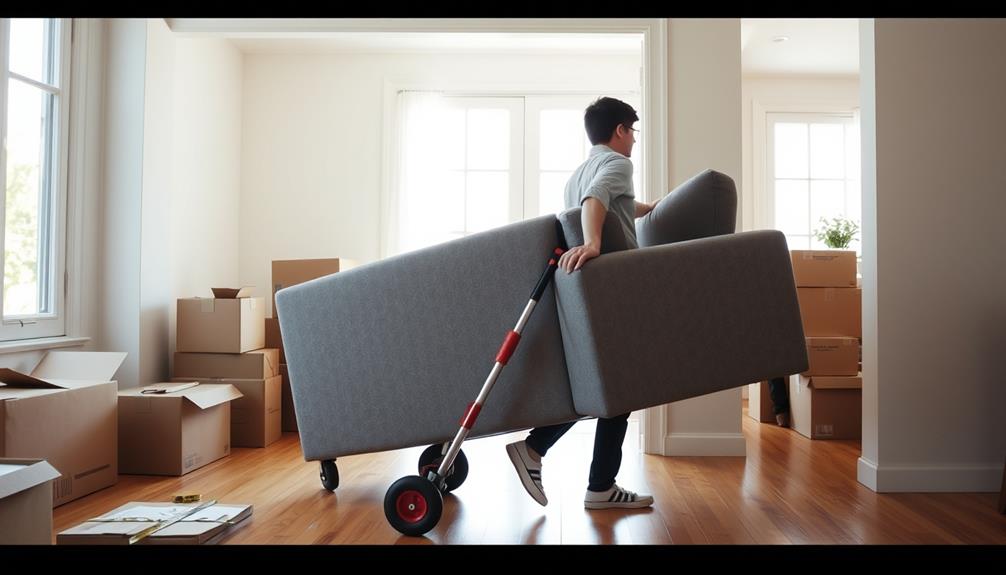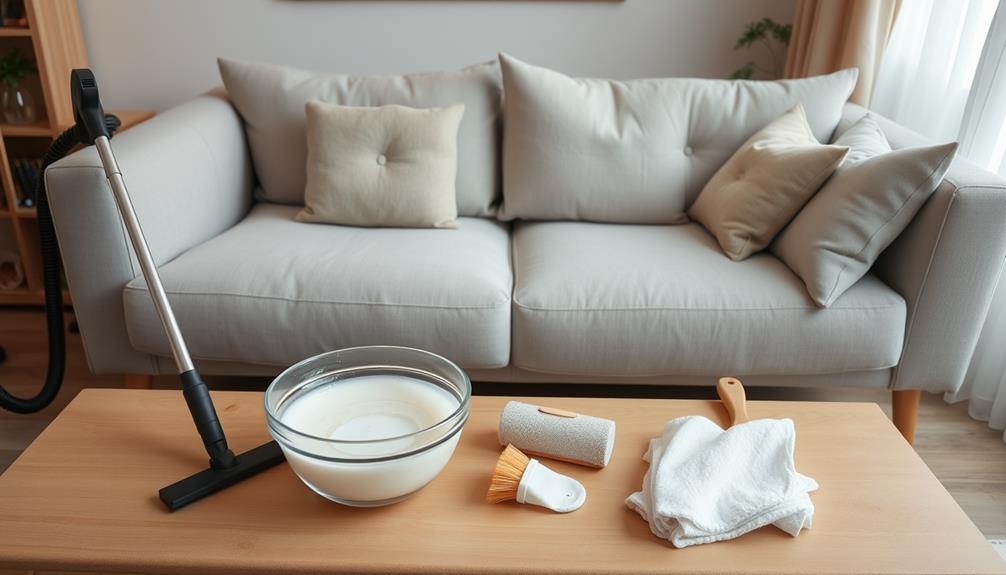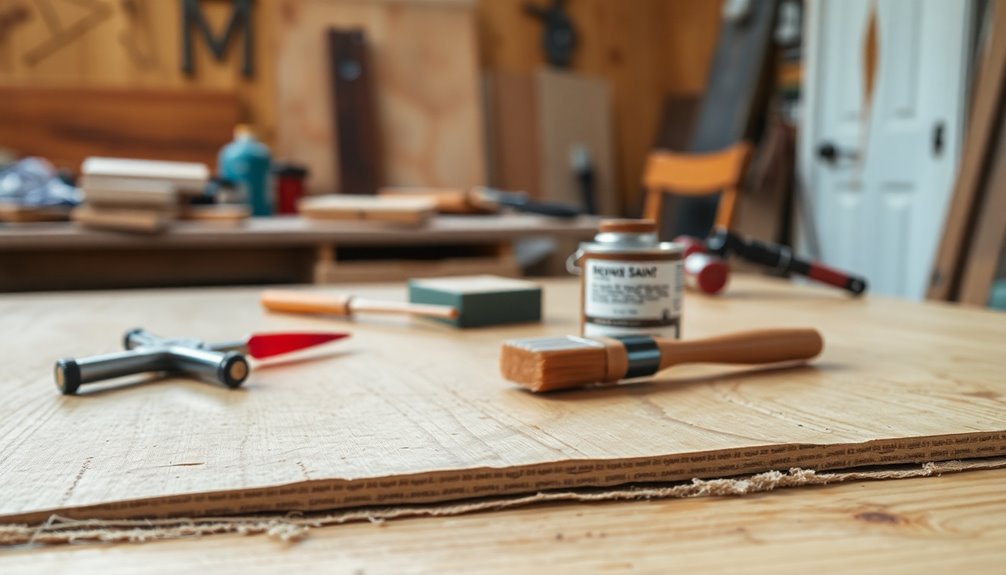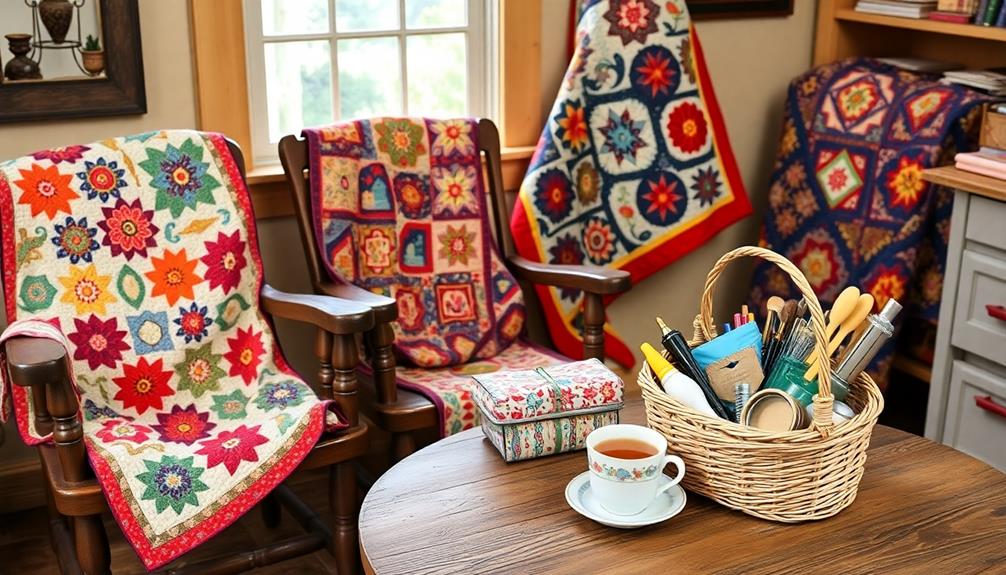When moving furniture alone, start by carefully planning the process. Measure your furniture and doorways, then clear paths of obstacles. Gather tools such as sliders and dollies for easier transport. When lifting, use proper techniques: keep your back straight, bend your knees, and lift with your legs. Break down larger pieces to make them lighter and use straps for stability. Load heavy items first in your vehicle for balance, and organize by room for efficient unloading. Remember to stay hydrated and take breaks. For more helpful tips on a smoother move, there is plenty more to explore. If you are moving into a smaller space, consider these small space furniture arrangement tips to maximize your new home. Look for multi-functional furniture pieces, such as a storage ottoman that can also be used as a coffee table. Utilize vertical space by incorporating shelves or hanging organizers to keep clutter off the floor. Feel free to experiment with your layout – try placing your furniture away from the walls to give the illusion of more space. By following these tips and using a bit of creativity, you can make your move and new space a breeze.
Key Takeaways
- Measure furniture and doorways to ensure a smooth moving process and avoid obstacles.
- Utilize equipment like sliders and dollies to reduce strain and protect your floors.
- Disassemble larger items to lighten the load and simplify transportation.
- Employ proper lifting techniques by bending your knees and keeping your back straight to prevent injuries.
- Organize unloading by room and plan furniture placement beforehand to streamline the process.
Preparation and Planning
Before you start moving your furniture, it's important to first assess your space and plan your approach.
Begin by measuring the height, width, and depth of each piece of furniture, along with any doorways or hallways you'll navigate. This guarantees you won't encounter any surprises during the move. Additionally, consider the importance of professional cleaning for your carpets and upholstery, as a clean environment can make your moving experience more pleasant.
Next, create a detailed plan for how you'll move each item. Identify the best route and note any furniture that may need disassembly for easier transport. Good preparation can save you time and effort.
Don't forget to gather critical tools before diving into the moving process. Sliders, dollies, and straps can make a huge difference in reducing strain on your body and help you maneuver heavy pieces more easily.
Additionally, clear all pathways of obstacles like toys, shoes, and loose rugs. This not only streamlines your moving process but also helps prevent accidents.
Safety Measures
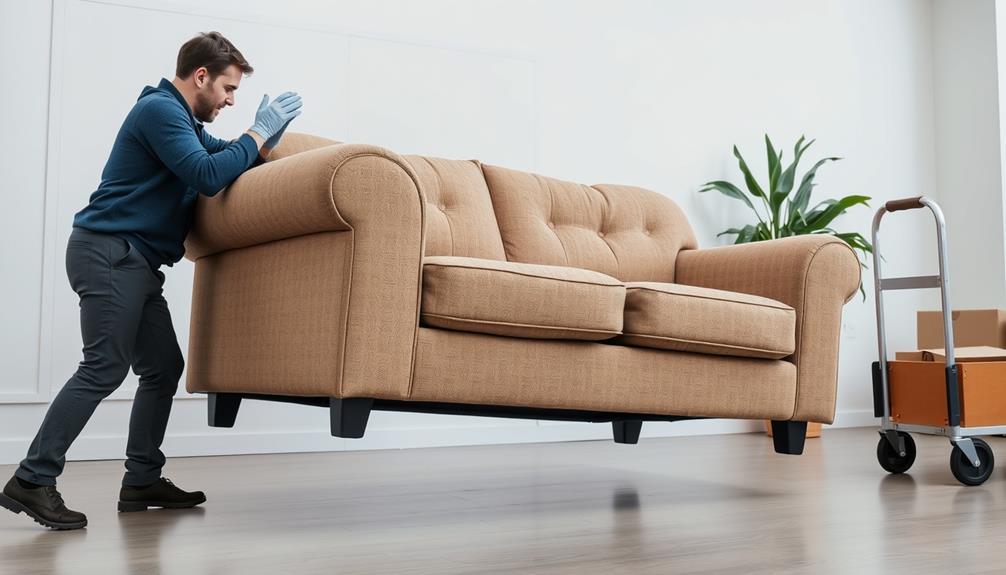
During your furniture moving process, prioritizing safety is essential to prevent injuries and guarantee a smooth experience. Implementing effective safety measures can make a significant difference, especially when handling heavy furniture.
It's also wise to incorporate practices that enhance your physical well-being, such as yoga for back pain, which can improve flexibility and reduce tension. Here are some tips to keep in mind:
- Keep a first aid kit accessible: Injuries can happen, so it's wise to have a kit nearby in case of accidents while lifting or transporting items.
- Stay hydrated: Drink plenty of water throughout the move. Dehydration can lead to fatigue, increasing the risk of accidents.
- Avoid overexertion: Take regular breaks to allow your body to recover. This helps reduce the chances of injuries when lifting heavy items.
- Inspect your moving area: Look for potential hazards like loose rugs or clutter. Clearing these obstacles can prevent tripping or falling while maneuvering furniture.
Additionally, ascertain children and pets are kept in a safe area away from your moving activities.
Lifting Techniques
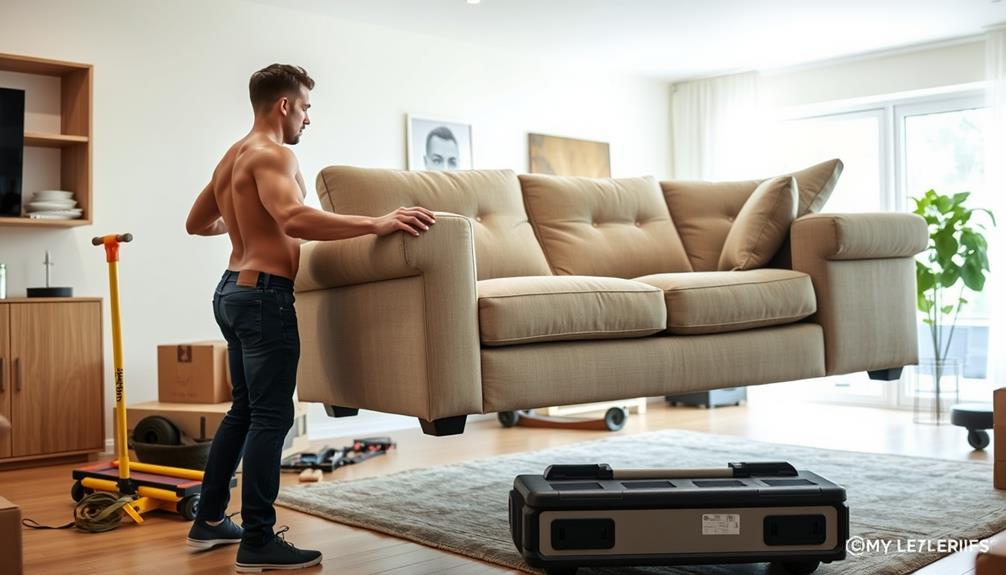
When you're lifting heavy furniture, using proper body mechanics is essential to avoid injury. Always lift with your legs, keep the item close to your body, and engage your core for support.
Additionally, consider the importance of common types of cold medications to guarantee you're in good health while moving.
Proper Body Mechanics
Lifting heavy furniture can be a challenging task, but using proper body mechanics makes it safer and more manageable. To protect yourself and guarantee a smoother move, follow these essential lifting techniques:
- Sturdy Base: Position your feet shoulder-width apart to enhance balance and stability.
- Lift with Your Legs: Bend your knees, keeping your back straight. This technique helps prevent strain on your spine.
- Keep It Close: Hold the object close to your body while lifting. This improves control and reduces the risk of injury.
- Avoid Twisting: Don't twist your body while carrying. Instead, pivot your feet to change direction, maintaining proper alignment.
Additionally, engage your core muscles throughout the lifting process. This provides extra support to your spine and helps distribute the load effectively.
By applying these techniques, you can lift heavy furniture with greater ease and safety, reducing the likelihood of injury.
Use of Equipment
Moving furniture becomes much easier with the right equipment at your disposal. Start by using a hand truck to provide stability and support when moving heavy items. Place the heaviest pieces at the bottom for better balance, making your journey smoother.
If you're dealing with heavier furniture, employ furniture sliders to reduce friction on your floors. This will let you glide those bulky pieces across surfaces with minimal effort.
Lifting straps are another game-changer. They help distribute weight evenly and give you handles for easier carrying, considerably reducing strain on your back and arms. When using lifting straps, always maintain a firm grip on the furniture to prevent slips.
If you're faced with larger items, consider disassembling them into smaller parts. This not only reduces weight but also simplifies the lifting process, making everything more manageable.
Safe Lifting Practices
To guarantee you lift furniture safely and effectively, it's crucial to adopt proper techniques that minimize strain on your body. Following these safe lifting practices can help you avoid injuries and make the process smoother:
- Bend your knees: Always lift with your legs by bending your knees and keeping your back straight. This technique helps you lift the furniture while reducing strain on your back.
- Stable base: Position your feet shoulder-width apart. This enhances balance during the lift and gives you a stronger foundation.
- Keep it close: Hold the object close to your body while lifting. This improves control and reduces strain on your back, making it easier to manage the weight.
- Avoid twisting: Instead of twisting your body while carrying, turn your whole body by moving your feet. This prevents back injuries and keeps your spine in a safe position.
Additionally, engage your core muscles to support your spine and distribute the load evenly.
Using Equipment
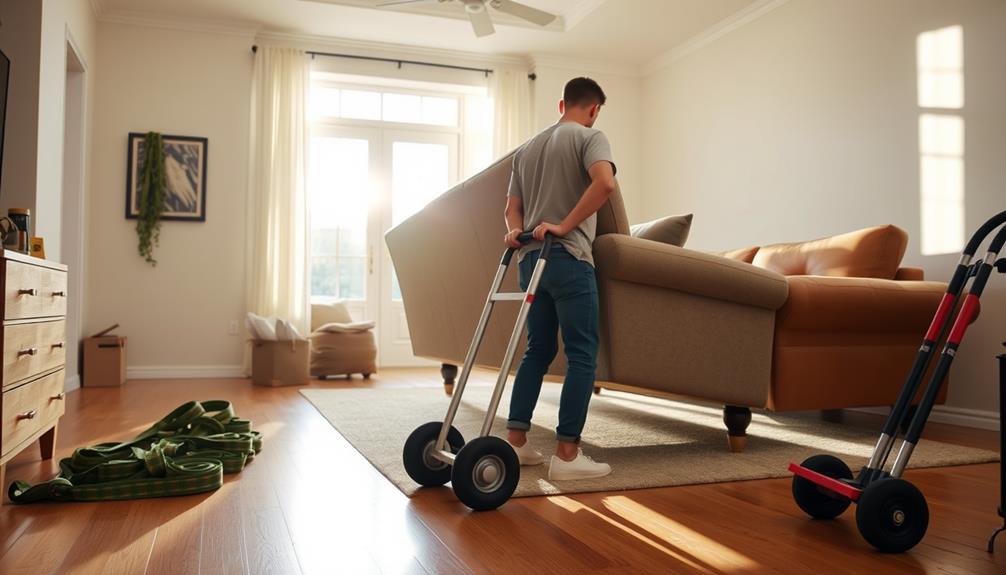
When it comes to transporting furniture, using the right equipment can make all the difference in your efficiency and safety. Start by utilizing furniture dollies for larger items. Place heavy furniture at the bottom for better stability and easier maneuvering.
For items with legs, consider using furniture sliders under each corner. This allows them to glide smoothly across floors, protecting surfaces from scratches.
If you're tackling bigger pieces, shoulder dollies are a great option. They evenly distribute weight across two people, greatly reducing strain on each mover.
When using a dolly, secure your furniture with moving straps to maintain control and stability during transport. This will help prevent accidents and keep your load steady.
Don't forget about your safety! Invest in protective gear, such as gloves and sturdy shoes, to protect yourself while handling heavy items and operating equipment.
Proper gear not only enhances your grip but also minimizes the risk of injury. By using the right tools and equipment, you can make your furniture moving experience smoother and safer.
Disassembly and Lightening the Load
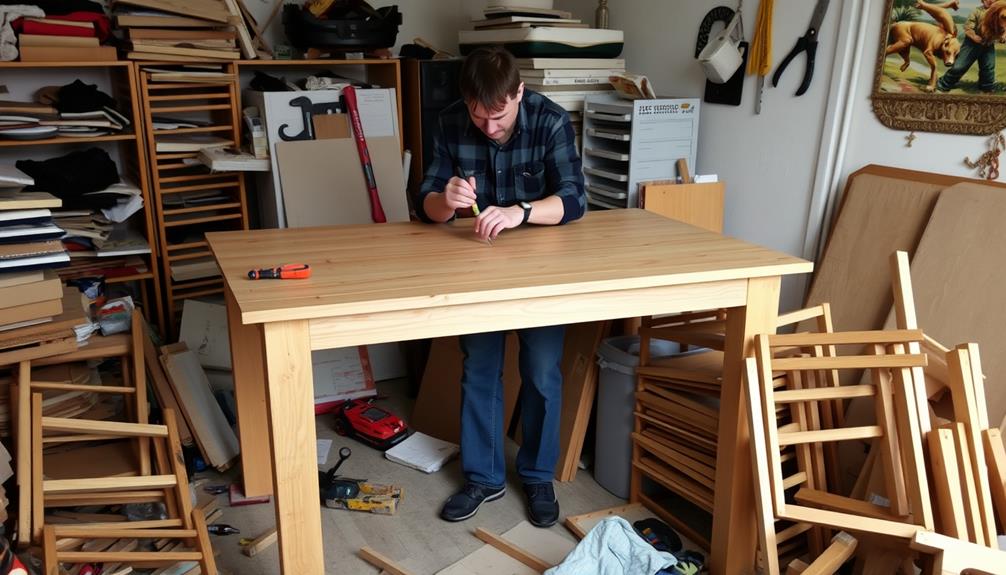
After you've gathered your equipment, think about disassembling larger furniture pieces to make them more manageable. By removing detachable parts, like legs or shelves, you can greatly lighten the load and reduce bulk for easier handling.
Here's how to effectively disassemble your furniture:
- Use the Right Tools: Grab screwdrivers or drills to dismantle the furniture efficiently without causing damage.
- Organize Small Parts: Keep screws and other small parts in labeled bags during disassembly to prevent loss and make reassembly a breeze.
- Photograph the Assembly: Take pictures of how the furniture is assembled before disassembly. This visual reference will simplify the reassembly process later.
- Pack Light: Consider packing lighter items, such as cushions or soft goods, inside larger pieces. This not only helps in lightening the load but also maximizes space during transport.
Disassembling your furniture not only eases the moving process but also protects your pieces from potential damage.
Loading and Unloading Techniques
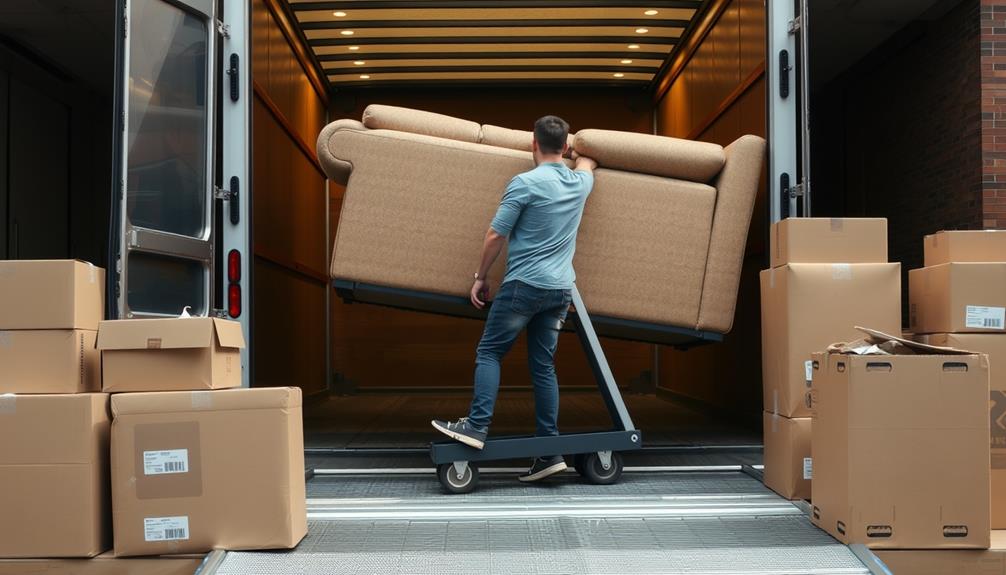
When loading your moving truck, start with the heaviest items to create a stable base and prevent shifting during transport.
Organizing your load by room destination makes unloading smoother and keeps everything in order.
Heavy Item Placement
Loading and unloading heavy furniture requires careful planning to guarantee safety and efficiency. To manage heavy items effectively, follow these key steps:
- Load Heavy First: Start loading heavy items into the moving truck first, placing them at the back. This creates a solid base and prevents shifting during transit.
- Stack Wisely: Arrange the heaviest items on the bottom, with lighter items stacked on top to maintain stability and reduce the risk of toppling.
- Use Tools: Utilize a foot pedal or hydraulic lift to elevate heavy items to truck height. This facilitates safe access and reduces strain on your back.
- Unloading Order: When unloading, prioritize heavy items first. Organize them by room to streamline the unpacking process and minimize unnecessary lifting.
After unloading, inspect all items for any shifts or damages that may have occurred during transport.
Address any issues immediately to avoid complications later. By following these techniques, you'll not only safeguard your heavy items but also protect yourself from potential injuries, making your moving experience smoother and more efficient.
Room-by-Room Organization
Organizing your items by room before you start unloading can greatly enhance your moving experience. This room-by-room organization makes it easier to place items efficiently as you enter each space. Start with the larger, heavier furniture first to clear the truck, making it easier for you to maneuver around.
Here's a quick checklist to keep in mind:
| Room | Items to Unload |
|---|---|
| Living Room | Couch, coffee table, TV stand |
| Bedroom | Bed frame, mattress, dresser |
| Kitchen | Table, chairs, major appliances |
| Bathroom | Towels, toiletries, storage bins |
| Office | Desk, chair, bookshelves |
Before unloading, plan where each piece of furniture will go to minimize lifting and repositioning. Also, use a checklist for each room to make sure nothing gets left behind. Don't forget to wear proper shoes for better grip and safety while moving heavy furniture. Finally, guarantee clear access paths in each room to reduce the risk of tripping or injury. This organized approach will save you time and effort, making your move smoother.
Frequently Asked Questions
How Can I Move Heavy Furniture by Myself?
When you need to move heavy furniture, consider using a dolly or sliders. Disassemble pieces for easier handling, and always lift with your legs to protect your back. Protect surfaces with blankets during transport.
How Do You Move Heavy Furniture by Yourself Sliders?
Imagine gliding a majestic ship through calm waters. You can achieve this with sliders! Just lift each corner, slide them underneath, and effortlessly push your heavy furniture across the floor, avoiding scratches and strain.
Can I Move Furniture on My Own?
Yes, you can move furniture on your own! Just assess the size and weight first, use tools like dollies or sliders, and remember to lift properly to avoid injuries and protect your floors.
How Do You Move a Heavy Couch Alone?
Did you know that nearly 50% of people injure themselves while moving furniture? To move a heavy couch alone, use furniture sliders, disassemble parts, and utilize a dolly for safer, easier transport through tight spaces. Additionally, it’s essential to take regular breaks and stay hydrated to avoid fatigue, which can lead to accidents. If you’re determined to move a sofa without help, consider utilizing straps to distribute the weight more evenly and protect your back. Always remember to lift with your legs, not your back, to minimize the risk of injury while maneuvering heavy items.
Conclusion
Moving furniture by yourself can seem intimidating, but with the right preparation and techniques, you can tackle it like a pro. Did you know that around 13 million people in the U.S. injure themselves each year while moving? By following safety measures, using proper lifting techniques, and utilizing equipment, you can minimize your risk and make the process smoother. So gear up, plan ahead, and take pride in your ability to move your furniture safely and efficiently! And don’t forget to consider the layout of the room when arranging small living room furniture. Take measurements, create a floor plan, and consider the flow of the space to ensure that your furniture placement is both functional and visually appealing. With the right approach, you can transform your space and avoid any unnecessary strain or injury.
